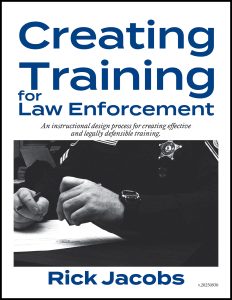 Creating Training for Law Enforcement provides a process for creating training that is based on decades of learning science and instructional design processes, but customized for the restrictions and needs of law enforcement. For instance, civilian organizations do not have to worry about direct and vicarious liability with every interaction and employee. Also, civilian organizational training does not have case law and precedence dictating what needs to be in training is rarely ever challenged in court.
Creating Training for Law Enforcement provides a process for creating training that is based on decades of learning science and instructional design processes, but customized for the restrictions and needs of law enforcement. For instance, civilian organizations do not have to worry about direct and vicarious liability with every interaction and employee. Also, civilian organizational training does not have case law and precedence dictating what needs to be in training is rarely ever challenged in court.
The foundational principle of this book is creating a process that documents every step of creating training, what I call creating a “training chain of evidence.” Courts and attorneys are starting to attack training design and function, as well as attacking the instructors who write it using their “background, training, and experience.” The days of “background, training, and experience” are over in the face of a science and research based learning industry. Instead, training needs to be based on “research, observation, and analysis.”
This process provides you the tools, documents, and templates, with explanations and tasking to use them. Every step of the process creates a piece of evidence of “why” the course delivers and assesses participant performance the way it does.
This is not a book on learning theories, tactics, or how people learn – there are plenty of books that already cover this. Instead, it provides a process, quality assurance methodology, and rigor that makes your training defensible if it comes to court, what we were not taught in instructor courses.
Law enforcement instructors are rarely taught more than “create an outline, objectives, slide decks, and a test.” This is one of the reasons that LE training is not as effective as it should be. Until instructors are trained on how to create training, true change and reform cannot occur, and we really need it to.
485 pages of:
-
- A process for creating defensible training using established and researched frameworks, methods, and concepts, and theories put to practice
- Design and evaluation methods for measuring performance – of the course and the participants through time.
- Templates, documents, examples, and activities to build a course while working through the book.
- Options for maximizing your learning experience with free access to videos, links for creating a class, and the ability to get a certificate of completion by completing tasks and receiving feedback.
$64.95 for the paperback
$ 44.95 for the electronic version

